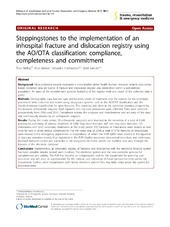| dc.contributor.author | Meling, Terje | en_US |
| dc.contributor.author | Harboe, Knut | en_US |
| dc.contributor.author | Arthursson, Astvaldur J. | en_US |
| dc.contributor.author | Søreide, Kjetil | en_US |
| dc.date.accessioned | 2011-04-08T09:10:28Z | |
| dc.date.available | 2011-04-08T09:10:28Z | |
| dc.date.issued | 2010-10-18 | eng |
| dc.Published | Scandinavian Journal of Trauma, Resuscitation and Emergency Medicine 18:54 | en_US |
| dc.identifier.issn | 1757-7241 | |
| dc.identifier.uri | https://hdl.handle.net/1956/4642 | |
| dc.description.abstract | Background Musculoskeletal trauma represents a considerable global health burden, however reliable population-based incidence data are scarce. A fracture and dislocation registry was established within a well-defined population. An audit of the establishment process, feasibility of the registry work and report of the collected data is given. Methods Demographic data, fracture type and location, mode of treatment, and the reasons for the secondary procedures were collected and scored using recognized systems, such as the AO/OTA classification and the Gustilo-Anderson classification for open fractures. The reporting was done in the operation planning program by the involved orthopaedic surgeon. Both inpatient and day-case procedures were collected. Data were collected prospectively from 2006 until 2010. Compliance among the surgeons and completeness and accuracy of the data was continuously assured by an orthopaedic surgeon. Results During the study period, 39 orthopaedic surgeons were involved in the recording of a total of 8,188 procedures, consisting of primary treatment of 4,986 long bone fractures, 467 non long bone fractures, 123 dislocations and 2,612 secondary treatments. In the study period 532 fractures or dislocations were treated at least once for one or more serious complications. For the index year of 2009, a total of 5710 fractures or dislocations were treated in the emergency department or hospitalized, of which the 1594 (28%) were treated at the inpatient or day-case operation rooms, thus registered in the FDR. Quality assurance, educational incentives and continuous feedback between coders and controller in the integrated electronic system are available and used through the features of the electronic database. Conclusions Implementing an integrated registry of fractures and dislocations with the electronic hospital system has been possible despite several users involved. The electronic system and the data controller provide for completeness and validity. The FDR has become an indispensable tool for the department for planning and education and will serve as a prerequisite for the conduct and execution of future prospective trials within the department. Further, other departments with similar electronic patient files may fairly easily adopt this system for implementation. | en_US |
| dc.language.iso | eng | eng |
| dc.publisher | BioMed Central | eng |
| dc.relation.ispartof | <a href="http://hdl.handle.net/1956/6443" target="blank">Implementation of a fracture and dislocation registry. Epidemiology and scoring validity of long-bone fractures</a> | eng |
| dc.rights | Attribution CC BY | eng |
| dc.rights.uri | http://creativecommons.org/licenses/by/2.0 | eng |
| dc.title | Steppingstones to the implementation of an inhospital fracture and dislocation registry using the AO/OTA classification: compliance, completeness and commitment | en_US |
| dc.type | Peer reviewed | |
| dc.type | Journal article | |
| dc.description.version | publishedVersion | en_US |
| dc.rights.holder | Copyright 2010 Meling et al; licensee BioMed Central Ltd. | |
| dc.rights.holder | Meling et al. | |
| dc.identifier.doi | https://doi.org/10.1186/1757-7241-18-54 | |
| dc.identifier.cristin | 518619 | |
| dc.subject.nsi | VDP::Medical disciplines: 700 | eng |

